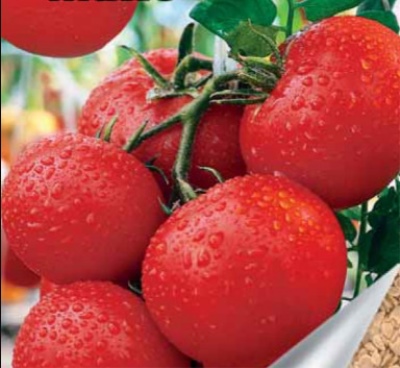
- Authors: Zhidkova V.A., Mikhed V.S., Arkhipova T.P., Korchagin V.V., Maksimov S.V., Sivashinsky I.V.
- Year of approval: 1998
- Category: grade
- Growth type: determinant
- Appointment: fresh consumption, for pickling and preserving
- Ripening period: early
- Ripening time, days: 102-106
- Growing conditions: for open ground
- Marketability: high
- Marketable fruit yield,%: 96
Even in a small area, an experienced gardener tries to arrange varieties with different ripening periods, providing a continuously fruitful tomato "conveyor". The first to open the season are early-ripening - unpretentious, cold-resistant varieties, one of which is the Max tomato.
Breeding history
Max is included in a series of copyright varieties and hybrids released by the Moscow Region Poisk company in collaboration with well-known amateur breeders. Together with LLC "Agrofirma Poisk", Valentina Andreevna Zhidkova, who is the author of many popular breeding developments of the late 1990s, is declared the originator. Max was included in the State Register in 1998 and received permission to grow in the open field and zoning in all 12 regions of the Russian Federation: from the North and North-West to the Far East.
Description of the variety
Tomato Max is an early ripe, high-yielding, unpretentious variety with low-growing (60-65 cm) bushes of a determinant type and rather large (120 g) flat-round fruits for salad purposes.
The main qualities of the fruit
Green fruits, as they ripen, acquire a rich, bright red color. They have a regular, rounded, slightly flattened shape. A weakly pronounced ribbing is visible at the peduncle. Max's tomatoes will not amaze with their gigantic dimensions, but they will delight you with a leveled crop of medium-sized tomatoes weighing 110-120 g.
The skin of the fruit is strong and elastic, does not crack, the pulp is fleshy, moderately juicy, there are 4 or more seed chambers. The variety is perfectly transported without damage and decay, it is well stored.
Taste characteristics
Max is one of the salad varieties recommended for fresh consumption in order to get the maximum of vitamins and nutrients. The fruits have a pronounced tomato aroma and excellent taste: a high sugar content of 4.7%, a low acidity of 0.4%. But if desired, these tomatoes can be salted, processed for sauce, ketchup, juice, used for cooking stews and snacks.
Ripening and fruiting
In this early variety, from the emergence of sprouts to the removal of the first ripe fruits, it takes from 100 to 106 days. Max's inflorescences are simple, begin to tie high: from the level of the 6th leaf with an interval of 1-2 leaves. 4-5 tomatoes are formed in each brush.
Fruits ripen in clusters at the same time, providing a bountiful harvest, so the variety is suitable for commercial cultivation. Ripe tomatoes should be picked regularly, and not left on the bush, then the next batch of young tomatoes will ripen more actively.
The fruiting period extends throughout the summer: from July to early September.
Yield
The originators declared the variety Max as a high-yielding variety. Amateur tomato growers confirm its fertility: the bush brings up to 4 kg. On large plantations, 450-520 centners are harvested from 1 hectare. The output of marketable products is very high - not less than 95%.
The timing of planting seedlings and planting in the ground
For growing seedlings, sowing is carried out in the second decade of March. Three weeks later, when the first leaves are formed at the seedlings, the seedlings are dived into individual containers or transplanted into larger ones. Seedlings are hardened, periodically taking them out into the fresh air and gradually increasing the time spent without shelter.
In southern regions with short winters from sowing to planting in the ground, they withstand a period of 50-55 days. In the middle lane, plants are planted in open ground at the end of May. If the cultivation will take place in a film greenhouse, then all activities are carried out 2-3 weeks earlier, and the seedlings are transferred to a permanent place in early May.

Growing tomato seedlings is an extremely important process, because it largely depends on whether the gardener will be able to harvest at all. All aspects must be taken into account, from seedbed preparation to planting in the ground.
Landing scheme
Low-growing semi-sprawling bushes with medium-sized leaves are placed in the garden according to the schemes: 70 x 30 cm or 50 x 60. Some gardeners plant plants quite densely, up to 5-6 pieces per 1 m². It is not worth over-thickening the plantation: this will complicate care, and increase the likelihood of being affected by fungal diseases.

Growing and care
The variety is loved by gardeners for its unpretentiousness in agricultural technology: some do not even stepchild these compact bushes. But the formation of 1 stem at times increases the yield and quality of the fruit, therefore pinching and garter are recommended by the originator. Otherwise, Max requires the usual care: loosening and mulching the soil, abundant, but not frequent watering, seasonal fertilizing.
The admission for cultivation in such a large number of regions is due to the excellent characteristics of the variety:
unpretentiousness to the composition of the soil;
cold resistance;
drought resistance;
resistance to weather changes.




A plant needs different micronutrients at each stage of growth. All fertilizers can be divided into two groups: mineral and organic. Folk remedies are often used: iodine, yeast, bird droppings, eggshells.
It is important to observe the rate and period of feeding. This also applies to folk remedies and organic fertilizers.
Disease and pest resistance
Most early-ripening varieties are characterized by immunity to late blight. But the Max variety can be affected by other fungal diseases.For example, excess moisture can lead to blackleg, a common disease of young seedlings.
From pests such as slugs and bears, folk remedies and biochemicals or planting certain odorous plants next to the bushes will help.



























































































